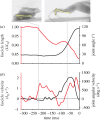Evidence for a vertebrate catapult: elastic energy storage in the plantaris tendon during frog jumping
- PMID: 22090204
- PMCID: PMC3367733
- DOI: 10.1098/rsbl.2011.0982
Evidence for a vertebrate catapult: elastic energy storage in the plantaris tendon during frog jumping
Abstract
Anuran jumping is one of the most powerful accelerations in vertebrate locomotion. Several species are hypothesized to use a catapult-like mechanism to store and rapidly release elastic energy, producing power outputs far beyond the capability of muscle. Most evidence for this mechanism comes from measurements of whole-body power output; the decoupling of joint motion and muscle shortening expected in a catapult-like mechanism has not been demonstrated. We used high-speed marker-based biplanar X-ray cinefluoroscopy to quantify plantaris muscle fascicle strain and ankle joint motion in frogs in order to test for two hallmarks of a catapult mechanism: (i) shortening of fascicles prior to joint movement (during tendon stretch), and (ii) rapid joint movement during the jump without rapid muscle-shortening (during tendon recoil). During all jumps, muscle fascicles shortened by an average of 7.8 per cent (54% of total strain) prior to joint movement, stretching the tendon. The subsequent period of initial joint movement and high joint angular acceleration occurred with minimal muscle fascicle length change, consistent with the recoil of the elastic tendon. These data support the plantaris longus tendon as a site of elastic energy storage during frog jumping, and demonstrate that catapult mechanisms may be employed even in sub-maximal jumps.
Figures


References
-
- Lutz G. J., Rome L. C. 1994. Built for jumping: the design of the frog muscular system. Science 263, 370–37210.1126/science.8278808 (doi:10.1126/science.8278808) - DOI - DOI - PubMed
-
- Roberts T. J., Marsh R. L. 2003. Probing the limits to muscle-powered accelerations: lessons from jumping bullfrogs. J. Exp. Biol. 206, 2567–258010.1242/jeb.00452 (doi:10.1242/jeb.00452) - DOI - DOI - PubMed
-
- Peplowski M. M., Marsh R. L. 1997. Work and power output in the hindlimb muscles of cuban tree frogs Osteopilus septentrionalis during jumping. J. Exp. Biol. 200, 2861–2870 - PubMed
-
- Marsh R. L. 1994. Jumping ability of anuran amphibians. Adv. Vet. Sci. Comp. Med. 38, 51–111 - PubMed
-
- Roberts T. J., Abbott E. M., Azizi E. 2011. The weak link: do muscle properties determine locomotor performance in frogs? Phil. Trans. R. Soc. B 366, 1488–149510.1098/rstb.2010.0326 (doi:10.1098/rstb.2010.0326) - DOI - DOI - PMC - PubMed
Publication types
MeSH terms
LinkOut - more resources
Full Text Sources

